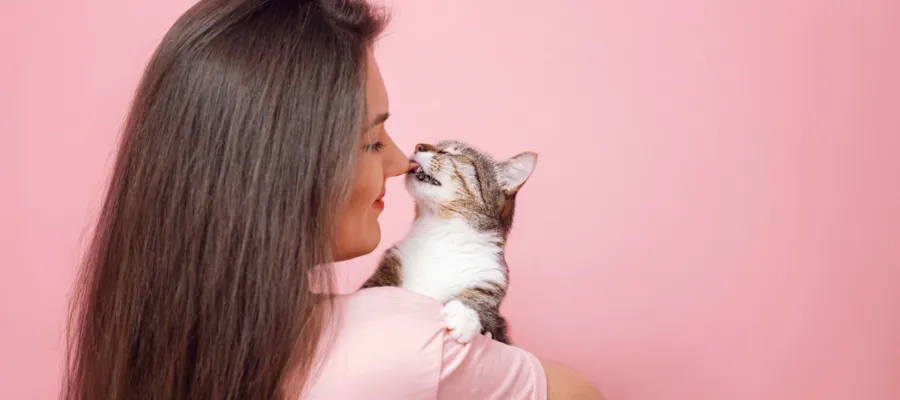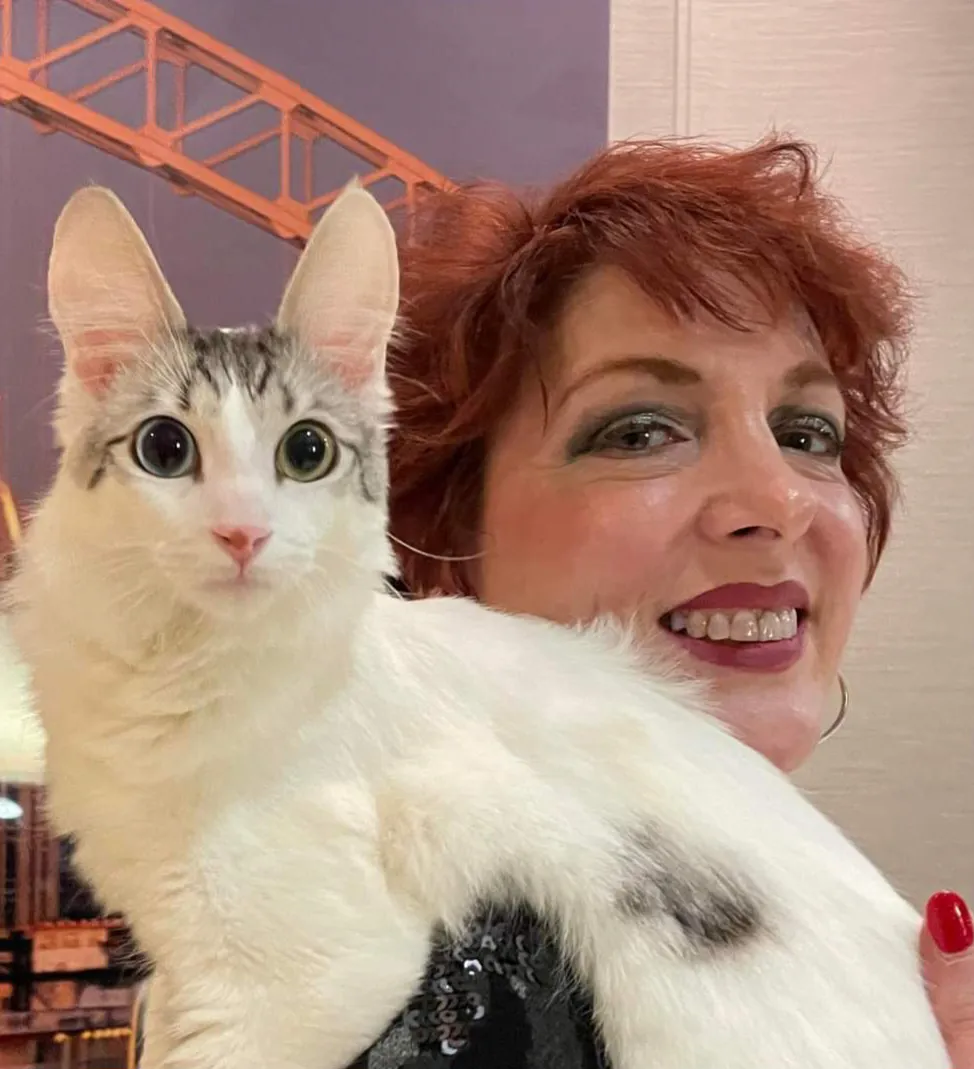What Do Cats and Teenagers Have in Common?
Posted - April 7, 2025

By Iris Zinck
Let’s see. . . nonexistent listening skills? Determination to go their way, no matter how you direct them? Hmm. . . maybe cats actually ARE teenagers! But the answer we had in mind happens to deal with skin conditions rather than personality characteristics. While Kitty may not need to agonize about covering up a prominent zit on her nose in time for a date, that doesn’t mean her owners are going to ignore a case of feline acne.
Nor should they!
How to Treat Feline Acne: Best Practices for Healthy Skin
What Is Feline Acne, and What Can We Do About It?
According to Clinician’s Brief.com, a resource used by many veterinarians, feline acne is a disorder of follicular keratinization. While veterinary researchers have identified several possible causes, they’ve also established that we know more about how feline acne occurs than why it happens. For reasons not yet fully understood, the cat’s sebaceous glands begin to produce excessive amounts of keratin, a protein found in the skin. The excess keratin blocks hair follicles and causes comedones (blackheads) to form. Result: one day, you look at your cat’s chin (or cheeks) and see what appears to be a dusting of black pepper! These comedones are not a pleasant discovery, especially when you start trying to figure out how to remove them. It’s important to do so because neglecting “kitty zits” can cause them to increase in size and number until they form a blackened crust. At that point, they are highly likely to lead to a secondary infection and require veterinary assistance.
So, job #1 quickly becomes fast, effective management of feline acne at its initial stages. But how do you clear up and banish the blackheads without irritating the cat’s skin? This writer has found a multi-stage process to be quite effective. First, use moisture and warmth (such as a washcloth soaked in hot water) to soften the affected area, then GENTLY work away the specks of keratin debris, using one of the cleaning products listed below.
- Benzoyl peroxide shampoo: It is a powerful cleanser well suited to tough cases. It works best when allowed to sit on the skin for a few minutes before you start to work on the chin with your washcloth.
- Chlorhexidine shampoo: It may be easier for some cats to tolerate as it is a bit milder than benzoyl peroxide and may smell better to the cats (it certainly smells nice to a human nose!). Don’t use chlorhexidine cleansers made for human use, as they are generally too strong for cats’ skin.
- For breeds with particularly delicate or sensitive skin, such as Sphynx or Peterbalds, consider ZYMOX Enzymatic Shampoo, which can help calm skin as it cleans.
Once you’ve removed the blackheads, apply a product that can soothe the cat’s skin and support the healing process. There are many options to choose from, and some may already be in your medicine cupboard or kitchen! Some of the most popular include:
- Aloe vera gel, which is soothing and hydrating, as well as anti-inflammatory. However, it can also be toxic to cats, and many of the websites that recommend it fail to disclose this. If you opt to use it, observe your cat carefully after application to ensure that s/he does not lick it, or keep a surgical cone on the cat for 10 or 15 minutes while the gel penetrates the skin and dries.
- Apple cider vinegar, a natural antiseptic, can be diluted 1:1 with water and dabbed on kitty’s chin with a cotton ball. Dr. Noelle Giddings, DVM, of Sunset Animal Hospital in Idaho, notes that astringents such as Seabreeze or Listerine mouthwash can be used the same way.
- In general, avoid drugstore products made for human acne, as they are typically too strong for cats’ delicate skin. One exception is the Sensitive Skin form of Stri-Dex medicated pads, which contain salicylic acid; it can help inhibit blackhead production and clear out the hair follicles.
- One of the more exotic product recommendations you may see online is manuka honey from New Zealand, which has been shown to have natural antimicrobial properties and is therapeutic for a number of feline skin issues. There’s also no need to be concerned if your cat should ingest a bit of it (though you’ll want to steer clear of using it with diabetic cats!)
Once you have removed the initial blackheads, you should find it easier to manage the condition and slow down its return by regularly wiping the cat’s chin with an antiseptic pad. A fortuitous discovery made while researching this article is that ZYMOX Ear Wipes, although designed for use inside cats’ and dogs’ ears, work very well for this purpose. The wipes are hypoallergenic, naturally cleansing, and include aloe vera to help prevent inflammation.
Other basic management tips for controlling feline acne can be as simple as cleaning your cat’s chin and mouth area after meals or avoiding the use of plastic dishes. There’s a wide perception that the rougher surface of plastic bowls harbors more bacteria than would be found on glass, ceramic or metal dishes, so using them could make cats more susceptible to infection. However, no evidence of a direct cause-and-effect relationship between plastic dishes and feline acne has been reported.
If the blackheads return or worsen after your initial cleaning and regular follow-up with wipes, you’ll need to investigate possible causes more thoroughly. This should be done with the help of your vet. According to Dr. Katie Pacer, DVM, of Westhampton Beach Animal Hospital in New York, cats may develop feline acne in response to allergies, environmental factors, stress, immunosuppression, or hormonal issues, and there can even be a genetic component. A Siberian breeder of our acquaintance reports having seen it in three generations of cats from the same line.
How Vets Can Help
A 2005 study of 22 cats affected with feline acne* found that over 50% of them had secondary bacterial infections. So, if your cat’s acne returns after your initial management attempts, a prescription medication may be needed. Mupirocin ointment, available at most pharmacies, is one of the most frequently prescribed topical treatments for this condition and has antibiotic properties. Some vets prefer to use Convenia, an injectable cephalosporin that has been proven effective against a variety of bacterial infections. This writer has had excellent luck with it, but many cat experts consider it controversial since it does have side effects and can remain in the cat’s system for as long as 65 days. In particularly challenging cases, where other treatments have not been successful, isotretinoin, a vitamin A derivative used to treat severe acne in humans, may be worth considering.
Your vet may also recommend a dietary supplement rich in Omega-3 and Omega-6 fatty acids to improve the health of the skin, as well as an immune system booster. One product that offers both these advantages is Imuquin, which is quite easy to administer; simply sprinkle it on your cat’s food.
In conclusion, while we may not understand the root causes of feline acne, we do have many ways to cope with it… possibly more solutions than the average teenager may have to choose from! And our cats won’t be at risk of having to miss the prom!

